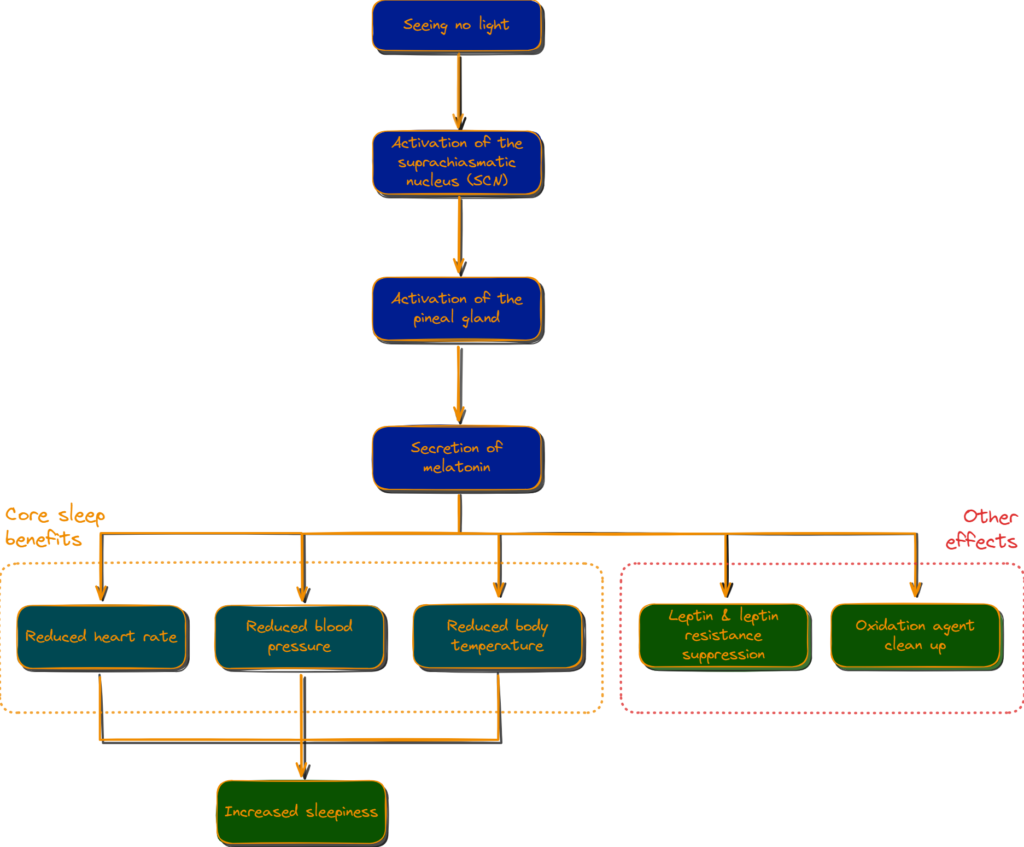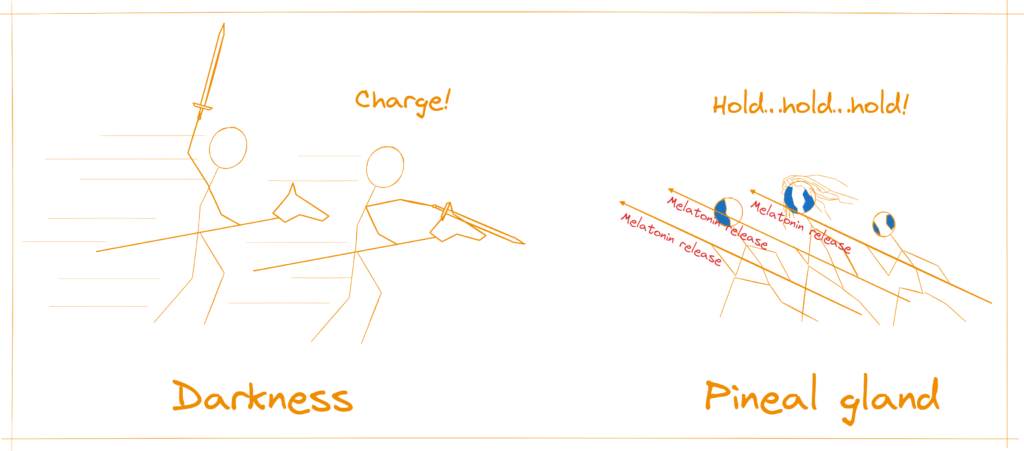TLDR: Light and through it melatonin are effective measures to control sleepiness and wakefulness in humans.
Intro
Every organism on earth is influenced by the sun. Without it no life would be possible, but the effect of the natural fusion-reactor in the sky doesn’t stop there [Rüth 2012].
It affects a human’s activity-levels throughout the day and even the night with the assistance of little chemical helpers. A major one of them is melatonin. In this article we are going to take a nosy look into the chain that starts with light and darkness signals, the release of melatonin and some of its effects on the human sleep-wake-cycle.
The melatonin-chain

When the sun goes down and the common human closes their eyes and snuggles into their nest of pillows and blankets, ready to rest and blissfully sleep, their light-sensors spring to a special form of action: Inaction.
But just as the german proverb goes: “No news are (good) news”, the human brain registers the lack of photonic inputs with the the same interest as it does a picture of the mona lisa and gets right to work.
The first stop of the signals that spark through the brain at the sight of darkness is the suprachiasmatic nucleus or SCN, in agent-speak. The SCN is a small but important region in the hypothalamus, situated directly above the optic chiasm [Hughes 2000]. But the chain doesn’t stop there.

Once triggered, the SCN activates a tiny pine cone shaped structure called pineal gland located on the epithalamus that jumps to action and secretes melatonin like a champ [Pfeffer 2018]. If the light signal is positive or in other words light is detected through the optic nerve, the switch is turned and the secretion of melatonin stops [Gooley 2011].
That is why melatonin-levels peak at night and ebb during the day, and this is why the SCN is the common human’s primary circadian clock [Hughes 2000, Zeitzer 1999].

Melatonin affects the whole body. It is an effective antioxidant, suppresses leptin and thereby the body’s resistence to it, reduces our heart rate, blood pressure, body temperature and it makes humans sleepy [Cagnacci 1997, Cajochen 1996, Chuang 1993, Karaaslan 2015, Scheer 2004, Suriagandhi 2022].
Outro
In closing, melatonin is one of if not THE primary actor to prepare the common human body for sleep [Cajochen 1996].
Sources
| Key | Citation |
|---|---|
| Cagnacci 1997 | Cagnacci, A., Kräuchi, K., Wirz-Justice, A., & Volpe, A. (1997). Homeostatic versus circadian effects of melatonin on core body temperature in humans. Journal of biological rhythms, 12(6), 509-517. |
| Cajochen 1996 | Cajochen, C., Kräuchi, K., von Arx, M. A., Möri, D., Graw, P., & Wirz-Justice, A. (1996). Daytime melatonin administration enhances sleepiness and theta/alpha activity in the waking EEG. Neuroscience letters, 207(3), 209-213. |
| Chuang 1993 | Chuang, J. I., Chen, S. S., & Lin, M. T. (1993). Melatonin decreases brain serotonin release, arterial pressure and heart rate in rats. Pharmacology, 47(2), 91-97. |
| Gooley 2011 | Gooley, J. J., Chamberlain, K., Smith, K. A., Khalsa, S. B. S., Rajaratnam, S. M., Van Reen, E., … & Lockley, S. W. (2011). Exposure to room light before bedtime suppresses melatonin onset and shortens melatonin duration in humans. The Journal of Clinical Endocrinology & Metabolism, 96(3), E463-E472. |
| Hughes 2000 | Howard Hughes Medical Institute. (2000). The Mammalian Biological Clock. https://www.biointeractive.org/classroom-resources/mammalian-biological-clock. |
| Karaaslan 2015 | Karaaslan, C., & Suzen, S. (2015). Antioxidant properties of melatonin and its potential action in diseases. Current topics in medicinal chemistry, 15(9), 894-903. |
| Pfeffer 2018 | Pfeffer, M., Korf, H. W., & Wicht, H. (2018). Synchronizing effects of melatonin on diurnal and circadian rhythms. General and comparative endocrinology, 258, 215-221. |
| Rüth 2012 | Rüth, C. (2012). Harnessing the power of the Sun: fusion reactors. Science in School, 22, 42-48. |
| Scheer 2004 | Scheer, F. A., Van Montfrans, G. A., van Someren, E. J., Mairuhu, G., & Buijs, R. M. (2004). Daily nighttime melatonin reduces blood pressure in male patients with essential hypertension. Hypertension, 43(2), 192-197. |
| Suriagandhi 2022 | Suriagandhi, V., & Nachiappan, V. (2022). Protective effects of melatonin against obesity‐induced by leptin resistance. Behavioural brain research, 417, 113598. |
| Zeitzer 1999 | Zeitzer, J. M. (1999). Physiology and anatomy of human circadian photoreception and melatonin regulation. Harvard University. |


Leave a Reply